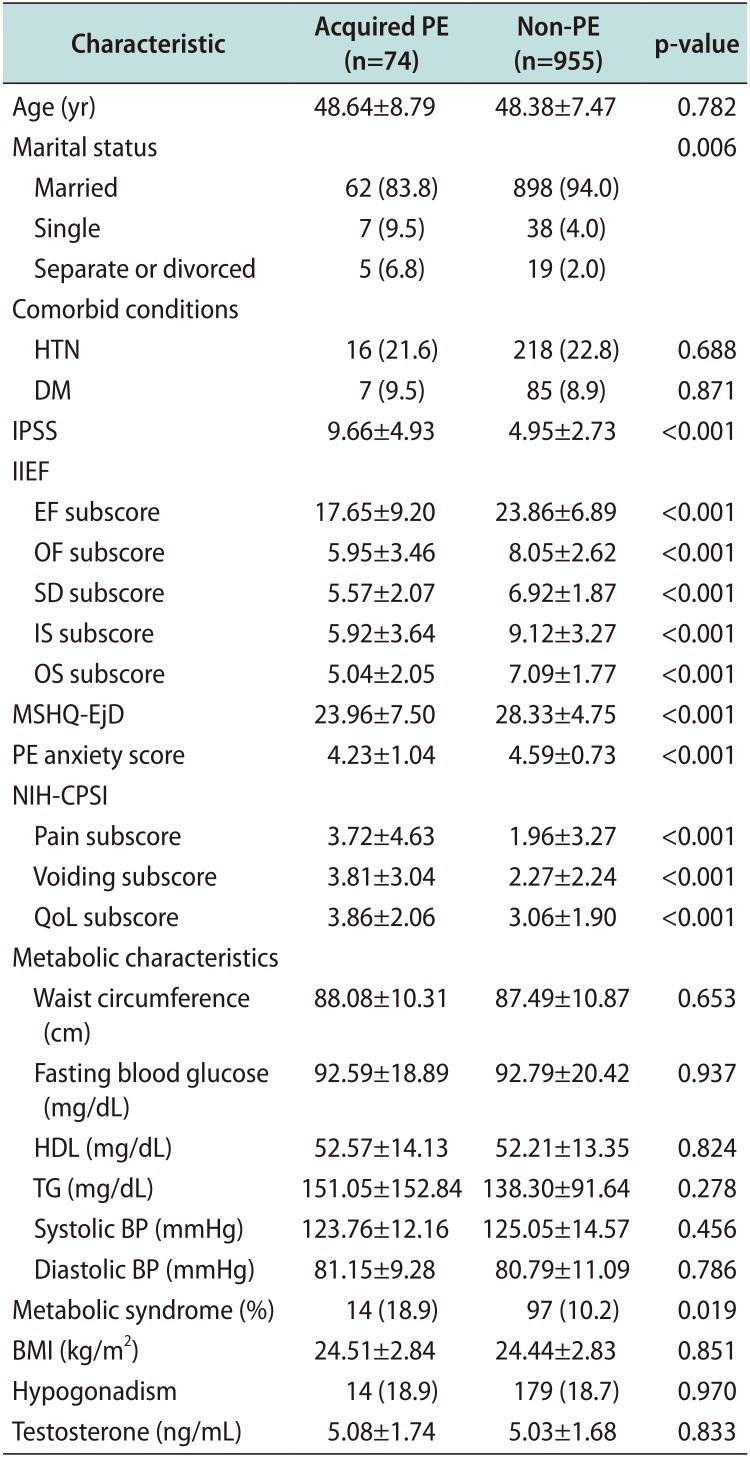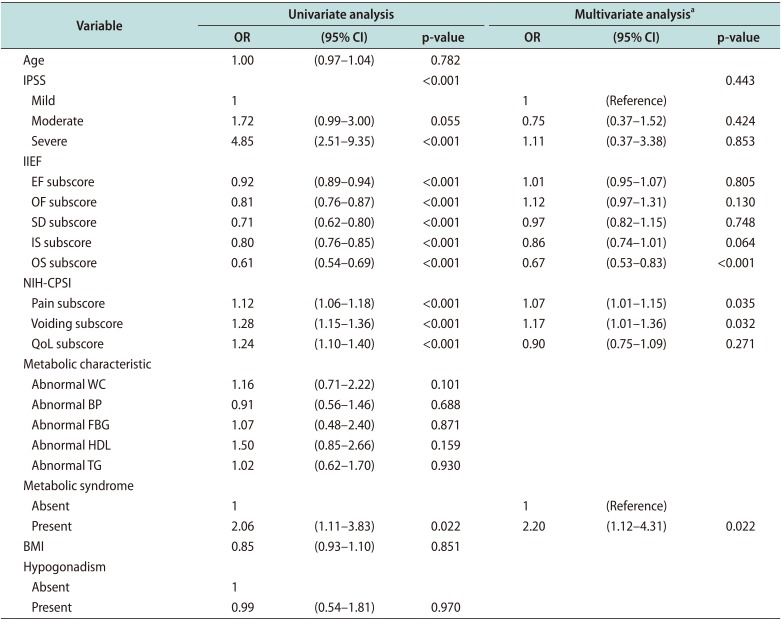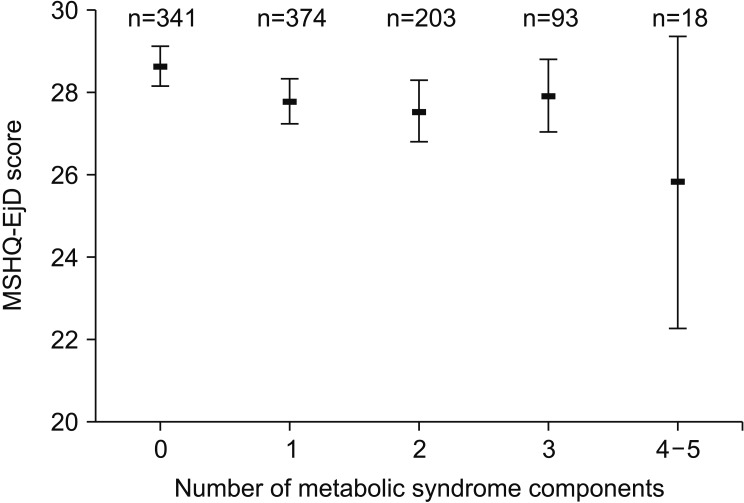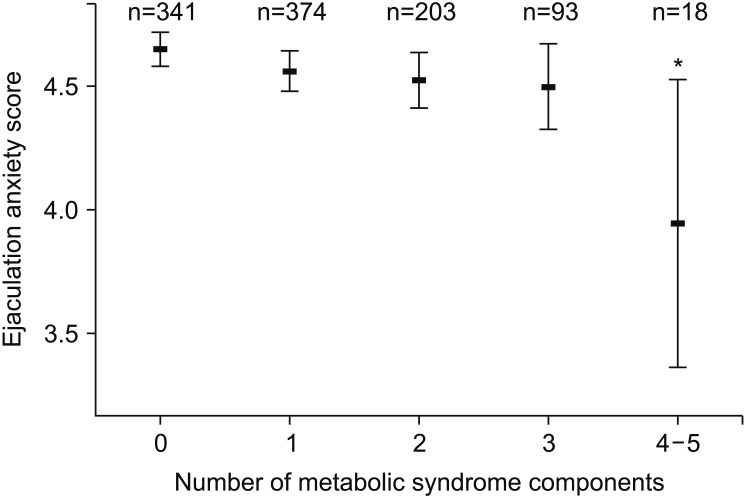1. McMahon CG, Lee G, Park JK, Adaikan PG. Premature ejaculation and erectile dysfunction prevalence and attitudes in the Asia-Pacific region. J Sex Med. 2012; 9:454–465. PMID:
22023395.

2. Lee SW, Lee JH, Sung HH, Park HJ, Park JK, Choi SK, et al. The prevalence of premature ejaculation and its clinical characteristics in Korean men according to different definitions. Int J Impot Res. 2013; 25:12–17. PMID:
22931761.

3. Serefoglu EC, McMahon CG, Waldinger MD, Althof SE, Shindel A, Adaikan G, et al. An evidence-based unified definition of lifelong and acquired premature ejaculation: report of the second International Society for Sexual Medicine ad hoc committee for the definition of premature ejaculation. J Sex Med. 2014; 11:1423–1441. PMID:
24848805.

4. Wein AJ, Coyne KS, Tubaro A, Sexton CC, Kopp ZS, Aiyer LP. The impact of lower urinary tract symptoms on male sexual health: EpiLUTS. BJU Int. 2009; 103(Suppl 3):33–41.

5. Laumann EO, Nicolosi A, Glasser DB, Paik A, Gingell C, Moreira E, et al. ; GSSAB Investigators' Group. Sexual problems among women and men aged 40-80 y: prevalence and correlates identified in the Global Study of Sexual Attitudes and Behaviors. Int J Impot Res. 2005; 17:39–57. PMID:
15215881.
6. Gonen M, Kalkan M, Cenker A, Ozkardes H. Prevalence of premature ejaculation in Turkish men with chronic pelvic pain syndrome. J Androl. 2005; 26:601–603. PMID:
16088036.

7. Corona G, Jannini EA, Mannucci E, Fisher AD, Lotti F, Petrone L, et al. Different testosterone levels are associated with ejaculatory dysfunction. J Sex Med. 2008; 5:1991–1998. PMID:
18399946.

8. Sullivan ME, Thompson CS, Dashwood MR, Khan MA, Jeremy JY, Morgan RJ, et al. Nitric oxide and penile erection: is erectile dysfunction another manifestation of vascular disease? Cardiovasc Res. 1999; 43:658–665. PMID:
10690337.

9. Vallance P, Chan N. Endothelial function and nitric oxide: clinical relevance. Heart. 2001; 85:342–350. PMID:
11179281.
10. Wheatcroft SB, Williams IL, Shah AM, Kearney MT. Pathophysiological implications of insulin resistance on vascular endothelial function. Diabet Med. 2003; 20:255–268. PMID:
12675638.

11. Heidler S, Temml C, Broessner C, Mock K, Rauchenwald M, Madersbacher S, et al. Is the metabolic syndrome an independent risk factor for erectile dysfunction? J Urol. 2007; 177:651–654. PMID:
17222651.
12. Skilton MR, Moulin P, Terra JL, Bonnet F. Associations between anxiety, depression, and the metabolic syndrome. Biol Psychiatry. 2007; 62:1251–1257. PMID:
17553465.

13. Pan A, Keum N, Okereke OI, Sun Q, Kivimaki M, Rubin RR, et al. Bidirectional association between depression and metabolic syndrome: a systematic review and meta-analysis of epidemiological studies. Diabetes Care. 2012; 35:1171–1180. PMID:
22517938.
14. Waldinger MD, Berendsen HH, Blok BF, Olivier B, Holstege G. Premature ejaculation and serotonergic antidepressants-induced delayed ejaculation: the involvement of the serotonergic system. Behav Brain Res. 1998; 92:111–118. PMID:
9638953.

15. Rosmond R, Bouchard C, Björntorp P. Increased abdominal obesity in subjects with a mutation in the 5-HT(2A) receptor gene promoter. Ann N Y Acad Sci. 2002; 967:571–575. PMID:
12079891.

16. Muldoon MF, Mackey RH, Williams KV, Korytkowski MT, Flory JD, Manuck SB. Low central nervous system serotonergic responsivity is associated with the metabolic syndrome and physical inactivity. J Clin Endocrinol Metab. 2004; 89:266–271. PMID:
14715860.

17. Bolat D, Kocabas GU, Gunlusoy B, Aydogdu O, Aydin ME. The relationship between acquired premature ejaculation and metabolic syndrome: a prospective, comparative study. Int J Impot Res. 2017; 29:105–109. PMID:
28179637.

18. Grundy SM, Cleeman JI, Daniels SR, Donato KA, Eckel RH, Franklin BA, et al. Diagnosis and management of the metabolic syndrome: an American Heart Association/National Heart, Lung, and Blood Institute scientific statement. Circulation. 2005; 112:2735–2752. PMID:
16157765.
19. World Health Organization. Regional Office for the Western Pacific. The Asia-Pacific perspective: redefining obesity and its treatment. Sydney: Health Communications Australia;2000. p. 11–12.
20. McMahon CG, Althof SE, Waldinger MD, Porst H, Dean J, Sharlip ID, et al. An evidence-based definition of lifelong premature ejaculation: report of the International Society for Sexual Medicine (ISSM) ad hoc committee for the definition of premature ejaculation. J Sex Med. 2008; 5:1590–1606. PMID:
18466262.

21. Takeuchi T, Nakao M, Nomura K, Yano E. Association of metabolic syndrome with depression and anxiety in Japanese men. Diabetes Metab. 2009; 35:32–36. PMID:
19046916.

22. Shoelson SE, Herrero L, Naaz A. Obesity, inflammation, and insulin resistance. Gastroenterology. 2007; 132:2169–2180. PMID:
17498510.

23. El-Nashaar A, Shamloul R. Antibiotic treatment can delay ejaculation in patients with premature ejaculation and chronic bacterial prostatitis. J Sex Med. 2007; 4:491–496. PMID:
17367444.
24. McMahon CG, Stuckey BG, Andersen M, Purvis K, Koppiker N, Haughie S, et al. Efficacy of sildenafil citrate (Viagra) in men with premature ejaculation. J Sex Med. 2005; 2:368–375. PMID:
16422868.

25. Lee WK, Lee SH, Cho ST, Lee YS, Oh CY, Yoo C, et al. Comparison between on-demand dosing of dapoxetine alone and dapoxetine plus mirodenafil in patients with lifelong premature ejaculation: prospective, randomized, double-blind, placebo-controlled, multicenter study. J Sex Med. 2013; 10:2832–2841. PMID:
23937271.

26. Nicolosi A, Laumann EO, Glasser DB, Moreira ED Jr, Paik A, Gingell C. Global Study of Sexual Attitudes and Behaviors Investigators' Group. Sexual behavior and sexual dysfunctions after age 40: the global study of sexual attitudes and behaviors. Urology. 2004; 64:991–997. PMID:
15533492.

27. Porst H, Montorsi F, Rosen RC, Gaynor L, Grupe S, Alexander J. The Premature Ejaculation Prevalence and Attitudes (PEPA) survey: prevalence, comorbidities, and professional help-seeking. Eur Urol. 2007; 51:816–824. discussion 824. PMID:
16934919.

28. Corona G, Rastrelli G, Maggi M. Treatment of premature ejaculation and comorbid endocrine and metabolic disorders. In : Jannini EA, McMahon CG, Waldinger MD, editors. Premature ejaculation: from etiology to diagnosis and treatment. Milano: Springer;2013. p. 289–303.
29. Jern P, Westberg L, Ankarberg-Lindgren C, Johansson A, Gunst A, Sandnabba NK, et al. Associations between salivary testosterone levels, androgen-related genetic polymorphisms, and self-estimated ejaculation latency time. Sex Med. 2014; 2:107–114. PMID:
25356307.







 PDF
PDF ePub
ePub Citation
Citation Print
Print





 XML Download
XML Download